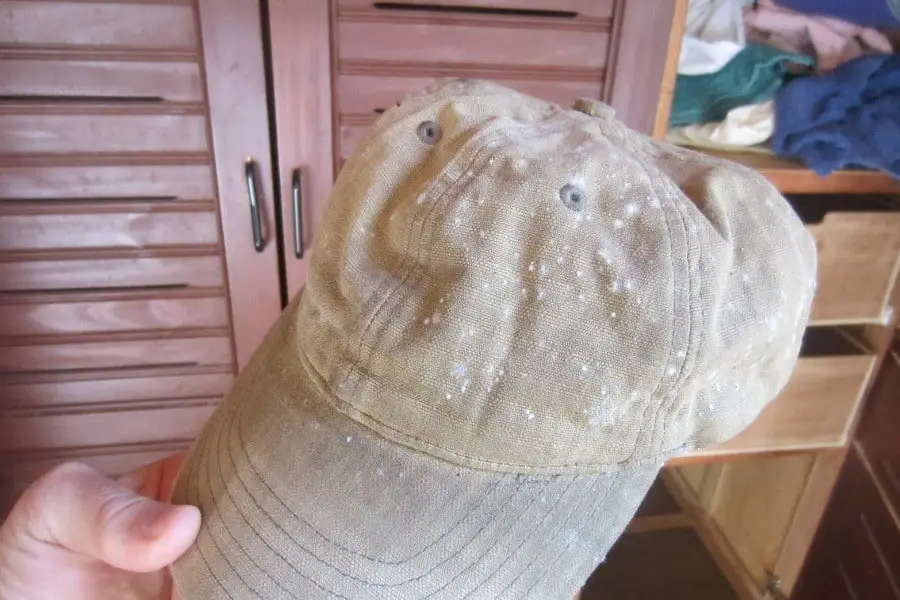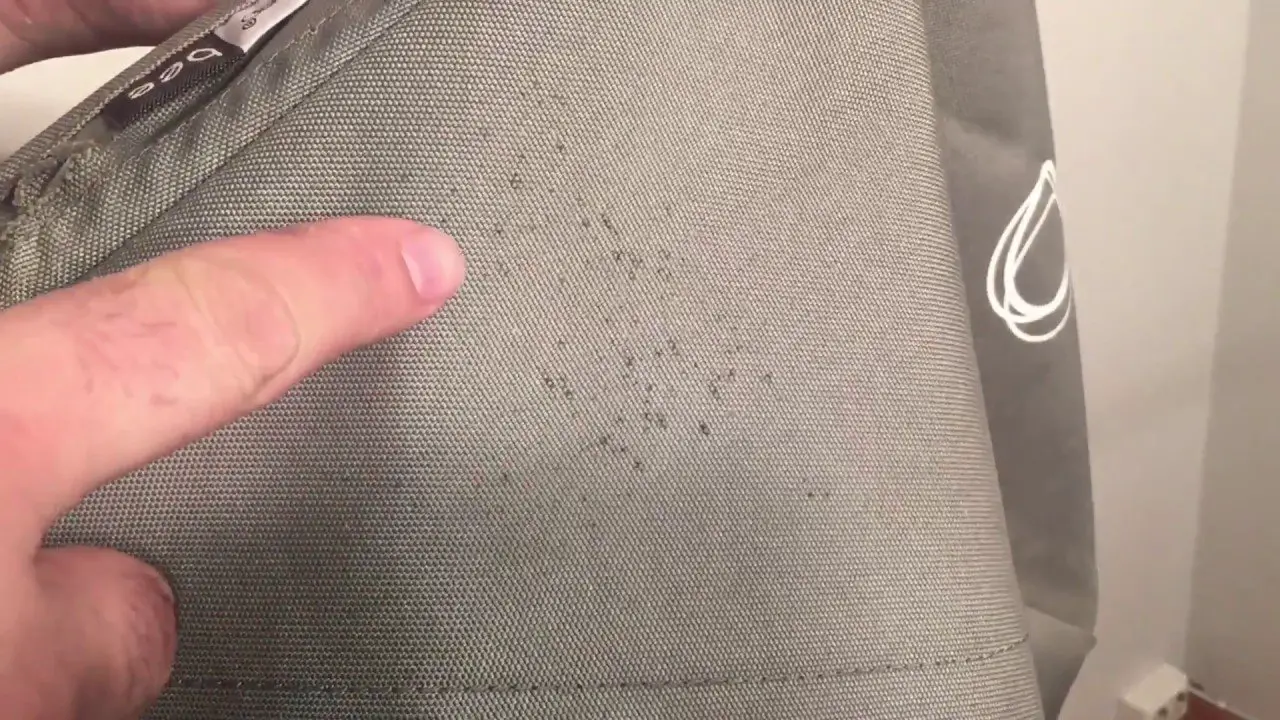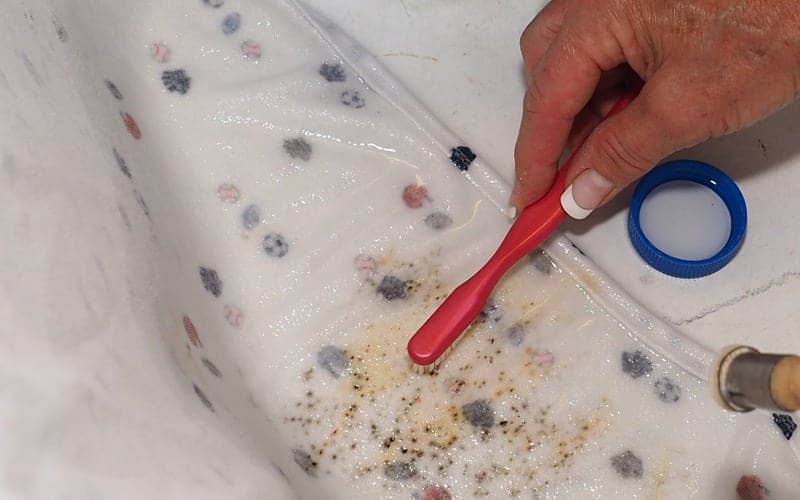How To Get Mold Out Of Clothes
There are several ordinary household products and ingredients that are highly effective at removing mold from clothes and fabrics such as distilled white vinegar, borax, bleach, baking soda, and hydrogen peroxide. We will discuss these below and also reveal some specialized mold-killing detergents.
Also, be sure to read the care labels on each item of clothing before using any of the following cleaning solutions.
How To Get Mildew Smell Out Of Clothes
The best way to get a mildew smell out of clothes is to use a vinegar and baking soda treatment that will kill the mold and neutralize the odor. You can do this quite simply by adding vinegar and baking soda to your washing machine!
This method works great on musty-smelling towels, too.
Other effective methods include hanging up the clothes in bright, hot sunlight. Let them rest for a couple of hours. The sunlight may kill the mildew and the fresh air will make your clothes smell good again!
If you can safely bleach your clothing, chlorine or oxygen bleach will kill the spores and remove the cause of the bad smell.
Finally, you can also use commercial products like a laundry enhancer to kill odors.
Can You Wash Mold Out Of Clothes
Most of the time, you can wash mold out of clothes, especially if you apply a special treatment first, such as using bleach or another cleaning product. That said, you may find that the mold has damaged the fabric of the garment. You may also have trouble fully getting rid of the mildewy smell.
Simply washing your clothes with detergent probably will not fully remove the problem. It may remove the visible stain, but the stain will just grow back again unless you treat the fabric with a mold-killing solution.
Fortunately, you can find many household and commercial products that kill most types of mold. Bleach is the best-known, but vinegar, borax, baking soda, and even tea tree oil can all kill mold as well!
You May Like: Best Way To Get Mold Off Bathroom Ceiling
Paper Plastic Coated Vinyl
CAUTIONS:
- Do not use the product on fabric or flocked wallcoverings.
- Be careful any time a commercial product or combination of cleaning supplies are used.
- Be sure to store and dispose of products/cans/containers as recommended. Keep out of reach of children.
- When using caustic, toxic, aromatic or flammable cleaning solutions, be certain to provide for adequate venti lation.
Try Bathroom Mildew Remover

This sounds a little unconventional, however spray a bathroom mildew remover on the stained areas if The Soak doesnt work.
Now here are some huge caution flags:
This is going to bleach your garment. Without a doubt, it will cause at the very least some lifting of the color if not all of the color.
It potentially could eat a hole in your garment also since mildew removers are largely made up of bleach.
The choice to use this type of product is really a last act of desperation. Hopefully, youre garment is white and it wont matter.
You can put a small amount on a Q-tip and test the inside seam to see if it will cause the item to fade. If it doesnt in just a few minutes, you can either spray the mildew remover straight on to the item or dab it on using a Q-tip on cotton ball.
I personally have used mildew remover with great success in the past. After youve left the product on about 5 minutes or so, wash on a regular cycle using a warm water temperature.
Again, hang the item to dry until you are sure the stain is removed.
Ive used X-14 and Tilex Mold & Mildew Remover with great success!
Also Check: Mould On Bathroom Ceiling
Symptoms Of Exposure To Mold
When someone gets sick after being exposed to mold, it’s often due to one of two things: either the person had been eating contaminated food or he/she got sick from breathing in toxic fumes.
People who eat moldy food develop gastrointestinal issues including nausea, vomiting, diarrhea, abdominal pain, bloating, gas, constipation, headaches, dizziness, fatigue, fever, loss of appetite, weight loss, and mouth sores.
Those who breathe in toxic fumes experience respiratory distress, coughing, wheezing, shortness of breath, chest tightness, difficulty swallowing, eye irritation, nosebleeds, sore throat, headache, muscle aches, weakness, confusion, memory lapses, depression, anxiety, panic attacks, heart palpitations, irregular heartbeat, seizures, coma, death, and other neurological disorders.
What Causes Mold In Closets
Mold can be caused by a number of things. Closets are dark, relatively warm environments that mold likes. Add in moisture from various sources, and you have an excellent place for mold to grow and thrive.
- One major cause of mold growth inside a closet is damp clothing. Whether it is clothing from the dryer that is not completely dry or towels and other items put inside the closet while still wet are one of the leading causes of mold growth.
- Another major factor for the growth of mold inside a closet is a water leak. Most bathrooms are backed by a bedroom with a closet. If pipe leaks inside the wall, the mold can grow because of the moisture and water coming through and sitting inside the closet. This can also cause growth in the items that are inside the closet as well.
- The third cause of mold is attic mold. Most homes these days have their attic hatch inside a closet, and these hatches are sometimes poorly insulated or not insulated at all. The cold, damp air from the attic combines with the warm air inside the closet, creating moisture on the hatch, and mold will grow on that and spread if not recognized quickly.
Don’t Miss: Remove Mold From Shower Ceiling
How To Remove Mold From Clothes With Borax
Borax is a natural mold killer which does not emit toxic fumes. To kill mold on clothes with borax you can either purchase borax laundry detergent or add borax powder yourself to your washing. Mix the borax with hot water before adding it to your washing to make sure it is completely dissolved.
How to wash clothes using borax:
Mold In The Closet Heres How To Get Rid Of It For Good
Last Updated on January 25, 2021 by Diana Rodriguez-Zaba
A hacking cough, chronic fatigue, and red, itchy eyes might be a sign of a hidden culprit: mold growing in your closet.
Toxic black mold thrives in dark, damp areas, releasing spores as it feeds on materials found in drywall, carpet, paper, cardboard, or fabric. Breathing in these spores can cause symptoms you might mistake for a respiratory infection or allergies.
More severe cases of mold poisoning can include nausea, vomiting, or bleeding in the lungs and nose.
Do you know how to remove mold in the closet?
Our certified ServiceMaster Chicago cleaning and restoration specialists have years of experience providing mold removal for area homeowners.
From attics to basements and even the cleanest closets, weve seen it all. We know why it happens, and we know how to prevent it too.
Lets get started.
Also Check: Diy Basement Mold Removal
Blended Fibers Fiberglass Fur Leather Natural Fibers Synthetic Fibers Vinyl Vinyl Coated Wool
* Look for products containing petroleum distillates or hydrocarbon such as trichloroethane, xylene methylenechloride, methane, benzene and/or naphtha. These chemicals may be found in such spot removers and cleaners as Guardsmans Afta, Dap Cleaner and Thinner, GOOF OFF, M-l Remover, Goo Gone, K2r, etc.
CAUTIONS:
Mold On Clothes Inside Your Closet
When clothing is put away inside a closet and is still damp, it is a great place for mold to form and grow. The clothing is damp the closet is warm and dark to provide a nice environment for the mold. It will start with just one or two spots of various colors depending on the type of mold spore that is growing .
Once well colonized, the mold will grow quite rapidly to the point where it will damage clothing that has not been worn recently. If you see mold starting to grow on your clothing, you will need to have it professionally remediated. If removed incorrectly, it could spread to other places in your home. Contact Mold Busters to have the mold correctly removed from your closet.
Also Check: Mildew Bathroom Ceiling
How To Remove Mildew Stains From Clothes
The appearance of mildew stains in your clothes can be the result of several factors, including moisture in your wardrobe or on your bedroom walls. Cotton and other organic materials are particularly perfect breeding grounds for mould or mildew. So, we must take special care with this type of clothing if we want to prevent this from happening. But, if moisture has permeated your clothes and you want to know how to remove mildew stains from clothes, in this OneHowto article we give you some very effective tips.
Mildew stains on clothes are very harmful, not just for your clothes but also for you. They can cause rashes, sneezing and other allergy symptoms. One way you can notice mildew stains before seeing them is through smell. When mildew stains are quite large, your clothes give off an almost unbearable strong odor of damp. Therefore it is important that you have control the moisture in your home to avoid the appearance of these stains.
A very effective way to remove mildew stains from clothing is to soak the garment in water and bleach. Add half a cup of bleach per litre of water and let the garment soak for an hour or two, depending on the size of the stain. Be careful not to use this method with coloured clothes as the bleach will discolour your clothes. Afterwards wash your clothes as normal.
If your problem is oil stains on clothes, check our tutorial.
For suede shoes use a suede cleaner and follow its instructions.
Vinegar + Baking Soda

Vinegar + Baking soda is quite effective at killing mould. This mixture can also produce very good results as a stain remover and when trying to remove mildew smell.
Mix 2 parts baking soda to 1 part of white vinegar.
You can add this to a bucket of hot water and soak the clothes in it before washing them or simply add the vinegar/ baking soda mix to the washing machine once it has filled with water and before the first wash cycle.
Do not mix vinegar and bleach as this combination can release a dangerous gas.
You also need to be careful to do a spot test in an inconspicuous place first in case the mixture causes discolouration.
You May Like: How To Remove Mold On Ceiling
Apply The Bleach Mixture
Now you can visit the spots where the black mold has infested the spray the mix on them. Make sure you dont miss any spot, or else youll still have some mold behind and they will grow again.
Be warned though, do not mix bleach with ammonia. Water is the best for mixing.
This is because a bleach and ammonia combination produces toxic fumes that are extremely dangerous to health.
In fact, the combination of both is more dangerous than the black mold itself.
For ease of application, you can make use of a mold fogger.
% Organic Green Bean Mold Liquid Detergent
100% Organic Green Bean Mold Liquid Detergent is safe, bio-degradable, and widely used by health care facilities and holiday resorts.
Its been specially formulated to treat mold and mildew on even the most fragile of fabrics. Its perfectly safe for hypersensitive allergy sufferers and is ideal for use on clothes, rugs, bedding, and more.
Furthermore, its 100% environmentally friendly and leaves everything you washed smelling clean and fresh.
Get the latest price from .
Recommended Reading: How To Clean Mold Off Ceiling
Getting Mold Out With Borax
Scrub With Baking Soda Or Borax
Sodium bicarbonate and the natural mineral borax each have a high pH that inhibits the growth and survival of mold. Both products are inexpensive and easy to use.
Make a paste of the powders with a few drops of water and apply it to the areas of mold growth. Let it sit for at least 30 minutes and then use a dampened scrub brush to scour the area. Rinse well with fresh water and dry with an old cloth.
Neither product is as effective at killing mold or removing stains as chlorine bleach or vinegar.
Don’t Miss: How To Remove Black Mold From Ceiling
How To Get Rid Of Black Mold Completely
Looking to get rid of black mold from your property or item? Here is a complete guide on dealing with mold issues.
One of the biggest issues with structural moisture is the growth of mold on the walls, clothes, floors, showers, and even on furniture.
And one of the most common mold species you will find in your home is black mold.
Besides giving your walls a terrible look, black mold can also be a health hazard.
It can cause allergic reactions and complicate pre-existing respiratory issues. We have compiled common mold problems in many homes.
In this article, we will be revealing the best ways to remove household mold.
Final Word On Black Mold: Best Avoidedbut Not Deadly
As for black molds toxic reputation, those with immune suppression, asthma, or other respiratory problems are most at risk of feeling ill.
Its not likely that youll die from black mold poisoning because its just not that toxic. That said, you should act quickly if you find it in your home. The good news is its treatable, removable, and preventable.
Also Check: Removing Mold On Bathroom Ceiling
Tips To Keep Black Mold Away Longer
- Reduce moisture levels in your home. According to the U.S. Environmental Protection Agency, humidity levels in homes should not exceed 60 percent.
- Repair leaks that keep surfaces wet.
- Add a dehumidifier and use heating and air conditioners to help reduce moisture levels.
- Install moisture barriers in basements.
- Clean mold-prone areas regularly to keep black mold growth in check.
Mold Allergy. Asthma and Allergy Foundation of America.
How To Get Rid Of Mold Inside A Closet

As with all forms of mold, removing mold on the structure of a closet is best left to professionals at Mold Busters. Its advised that homeowners not remove mold colonies inside their homes as mold spreads easily and could be dangerous. Without proper techniques and personal protective equipment, you could be making yourself and your family sick. If there is a bit of mold growth on some clothing items, remove them, wash them thoroughly, and make sure they are completely dry before putting them back into the closet.
Read Also: Stair Nose Molding For Vinyl Plank Flooring
Is There A Way To Tell How Long Mold Has Been Growing On Your Clothes
There are several ways to tell whether mold has grown on your clothes. One method involves looking at the texture of the fabric. When mold begins to grow, the fibers become stiffer and more brittle than normal. Another way is to look closely at the surface of the cloth. Dark spots indicate growth while lighter patches show no sign of contamination.
Acoustical Tile Dry Wawgypsum Board Plaster Tile
CAUTIONS:
- Be careful any time a commercial product or combination of cleaning supplies are used.
- Always pretest each cleaning agent on an inconspicuous area first to determine colorfastness.
- Be sure to store and dispose of products/cans/containers as recommended. Keep out of reach of chi Idren.
- When using caustic, toxic, aromatic or flammable cleaning solutions, be certain to provide for adequate venti lation.
Don’t Miss: Black Mold Ceiling Bathroom
